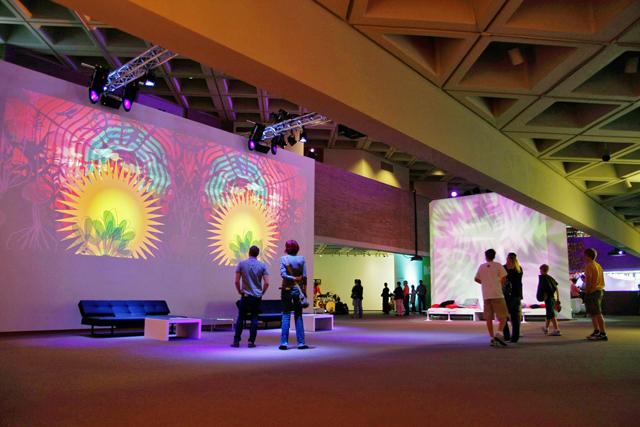
Photo by Tim O'Brien
The new and improved North Carolina Museum of Art opened last weekend and I was lucky to attend Saturday, opening day. The new building is sleek and modern with wood floors and a glass exterior that lets in natural light that was missing from the old building. The grounds themselves are even a work of art; the buildings and trails spell out the words “PICTURE THIS!,” a message that is fully visible only from aircraft. From the landscaping to the building all the way down to the cool sinks in the bathroom, the new museum is a marvel.
The modern and contemporary collection is the one that has been expanded the most. My favorites of the previous collection are still there and they include Frank Stella’s “Ragga II,” Alex Katz’s “Six Women” and Anselm Kiefer’s “Untitled.” Each of these three is a larger than life work and are must-sees. One of my favorite new pieces was a video instillation by artist Michal Rovner called “Tfila” which consists of an open book in a case with letters that move and change shape.
The museum recently acquired a painting by Pablo Picasso entitled “Seated Woman, Red and Yellow Background, 1952,” and it is quite extraordinary. It is a powerful work and I enjoyed it more than any piece in the recent Picasso exhibit at the Nasher Museum of Art in Durham. Many of the previous pieces from the contemporary collection have been placed within the expanded African collection. This is great because it allows you to see the influence of old art on new African painting and photography.
The American collection has also been expanded and re-organized. The highlights of the American collection include three paintings by John Singleton Copley, three paintings by Andrew Wyeth and a piece by Georgia O’Keefe of a prairie church. A portrait of Ben Franklin and a portrait of George Washington have also been added to the collection. These two founding father portraits hang across from a more recent work that uses silhouettes of the founding fathers and re-imagines the stars and stripes which makes for quite an interesting contrast.
The European collection has been expanded to include thirty casts of works by Rodin which includes some of his most famous works. The cast of Rodin’s “The Thinker” (which depicts Dante composing “The Divine Comedy”) sits in the courtyard and beckons you to the front door. Inside, the Rodin pieces populate the center of the museum and are a great addition to the collection. In the middle of the European collection, there is a new work that recreates the “Mona Lisa” using only thread spools. Strangely, the new Mona is upside down.
The European collection houses one of my favorite paintings in the museum, which is “The Dentist” by the aptly named Dutch painter Jan Miense Molenaer. This painting depicts a boy who is having a tooth pulled out by a swarthy “dentist” armed with a pair of pliers while his smiling mother watches. The boy is also clutching a rosary in a futile attempt for pain relief. This may sound frightening—it is—but is also quite hilarious and well made.
As for the negatives, I sometimes felt that it was almost too open. I like museums that have dead ends and seemingly hidden areas where paintings lurk in quiet solitude, but in the new building, everything seems packed too close together. The gift book of the collection is also quite overpriced—it comes only in hardcover and costs $60. While I do feel that the new building is far superior, I miss the old building and its 1970s architecture, which had its own character. The new building seems more generic, but I do think that an update was necessary and the results are wonderful.
While the museum is public and state run, it is mostly funded by private donations. Unlike many other museums of similar quality, the North Carolina Museum of Art is free. Most museums I have been to cost upwards of $20 per ticket. For a collection of this caliber, that is a steal. I am so thankful that we support public art because it gives us all—regardless of income—a chance to experience thought-provoking painting and sculpture and to be inspired to think more deeply about the world around us.